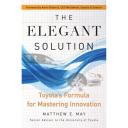The author offers three of Toyota principles – ingenuity in craft, pursuit of perfection, and fit with society. The emphasis is on simplicity when it comes to being “elegant.” And the ingenuity needed to create the elegant solution usually comes from the frontline people, not a group of high-ranking executive. It’s about making the best use of one’s expertise while openly exploring the possibilities and defining the task at hand. It’s about asking the right question. The story about this guy being dropped into a role and told to “dig” the role/job was something I would not have expected from a Japanese’s control-and-command style.
Continuous improvement (Kaizen) is a big part of Toyota’s culture, practiced by everyone. Kaizen means asking what is blocking perfection, instead of what can we improve? It involves “system thinking” – the ability to provide a solution within the current context.
The ten practices:
1. Let learning lead – learning and innovation go hand-in-hand, but learning comes first. The company teaches the softest skill of thinking critically. The tool used is IDEA: Investgate, Design, Adjust, and the Execute.
2. Learn to see – understanding customer’s world. “Genchi genbutsu:” go and see.
3. Design for today – focus on clear and present needs – Toyota’s term is “market-in.” It’s not just about “fit-it.”
4. Tell the story with pictures: visualize it.
5. Capture the intangible: perceptual and emotional. Find the most compelling value that is at the heart of what motivates purchase behavior.
6. Leverage the limit: resource constraints can spur ingenuity. Don’t just “satisfice” – doing just the minimum to achieve the goal.
7. Master the tension and harmonize the opposing “dynamic tensions”: Breakthrough thinking demands breaking through obvious, easy solutions. I like the fact that they don’t think “win-lose” with the opposing tensions. Thinking win-win creates breakthrough solutions.
8. Run the numbers or accessing relevant data:
9. Make Kaisan mandatory: Pursuing perfection requires great discipline. Create a standard, follow it, and then find a better way. This is almost like a staircase-like improvement so you have a solid baseline to fall back on, instead of rolling down the hill when things go wrong.
10. Keep it lean: get the heart of elegance through simplicity. “Complexity destroys value, which is what customers want most.” The most elegant solution are shockingly simple. Becoming lean requires fighting the basic human instinct to add, accumulate, and store. Lean requires a precise understanding of value: the who, what, when, where, how and why of the customer’s need.
To implement these ideas, the author describes the “clamshell” strategy: the manager provides the necessary cover and support from the top, and the team does the “heavy lifting” from the bottom. According to the author, big change only comes with little steps; that getting a little better each day does result in sustainable market leadership.
This is a great book about a great company, Toyota, and its success story. It did not happen by accident, if the culture is indeed what has been described. These are the small steps to greatness for any company, small or large or even individuals.

